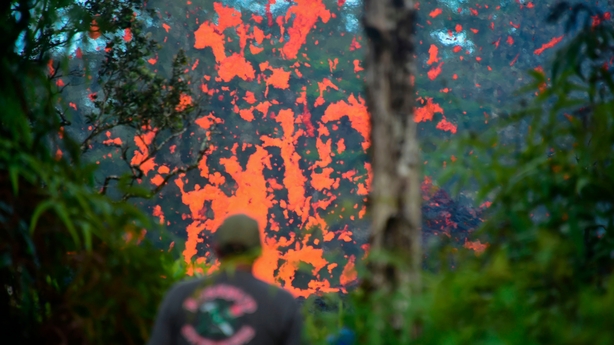More destructive lava flows could soon hit Hawaii’s Big Island as the Kilauea volcano erupts, posing a greater threat than oozing magma that has so far destroyed dozens of homes and forced thousands to evacuate, scientists have said.
As a lava lake at Kilauea's summit drains inside the volcano, magma is running underground.
It could burst to the surface as large, fast-moving and intensely hot lava flows and produce higher levels of toxic gases, Hawaiian Volcano Observatory scientist-in-charge Tina Neal has said.
"What will take a turn for the worse in terms of hazard is if hotter, fresher magma makes it to the surface, and that could be what is coming," Ms Neal said.
"Once a new batch of hotter, gassier magma makes it to the surface we might see larger, higher eruption rates," she said.
Fifteen large cracks or fissures have opened on the eastern flank of Kilauea since the volcano erupted eight days ago.
The volcanic vents have oozed relatively cool, sluggish magma leftover from a similar event in 1955. Fresher magma could now emerge behind it.

In addition, Kilauea, one of the world's most active volcanoes, threatens to begin a series of explosive eruptions within days or weeks that could form huge clouds of volcanic smog, or vog, and hurl boulders as big as small cars.
Geologists expect new lava outbreaks in or around the hard-hit Leilani Estates area in the southeastern Puna district, about 32 km south of Hilo, where 27 homes have been destroyed and all 1,900 residents have been evacuated.
Local residents got a text message alert at 11am on Friday warning them they could have little or no time to evacuate in the event of future eruptions.
"We are telling people to plan for the worst. They should have a Plan A, a Plan B and a Plan C," said Roann Okomura, a county official who is helping run one of the shelters set up for evacuees.
While locals contend with lava and gas on the ground, explosions at Kilauea's summit some 40km to the west were dusting communities with ash that irritated eyes and breathing.
South of Leilani Estates, in the Kalapana-Seaview neighborhood, residents are on high alert as the air quality is low and there are very few ways out of the area if an evacuation is ordered.
Volcanic smog may be blowing hundreds of miles from Kilauea, with people on the streets of state capital Honolulu, around 340km northwest on the island of Oahu, complaining it was "very voggy" on Friday.

